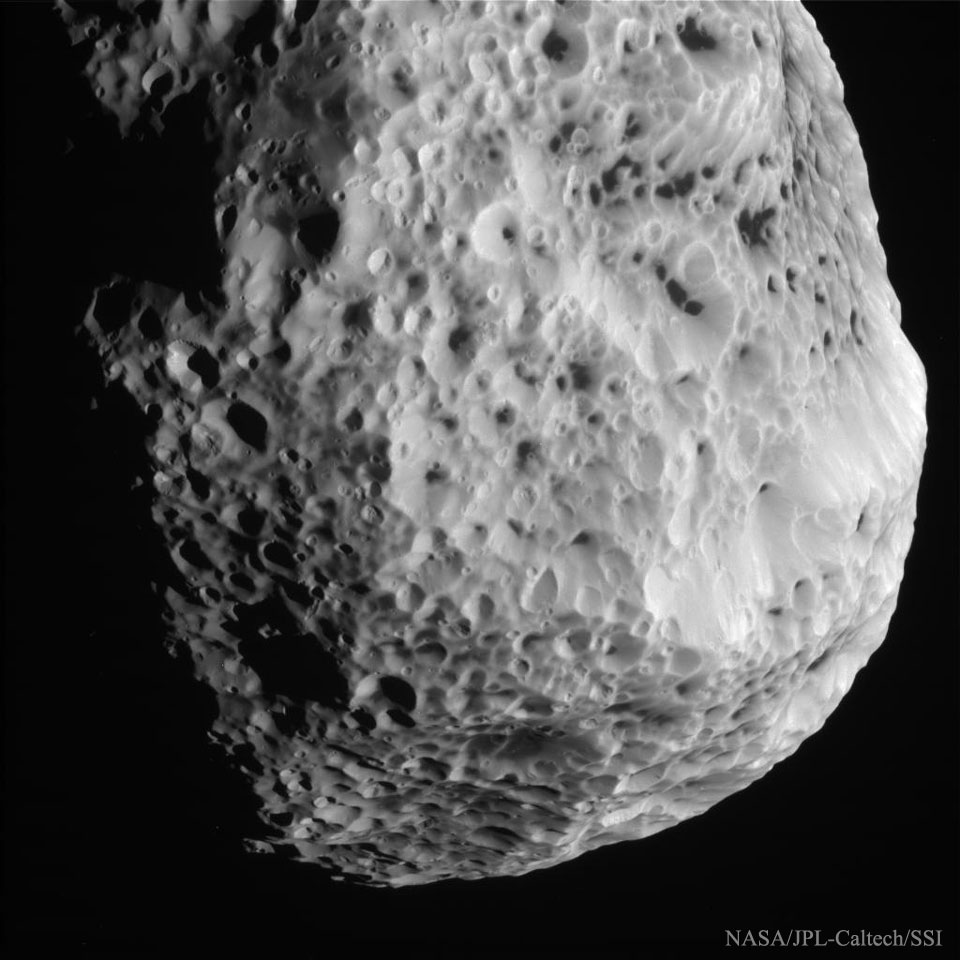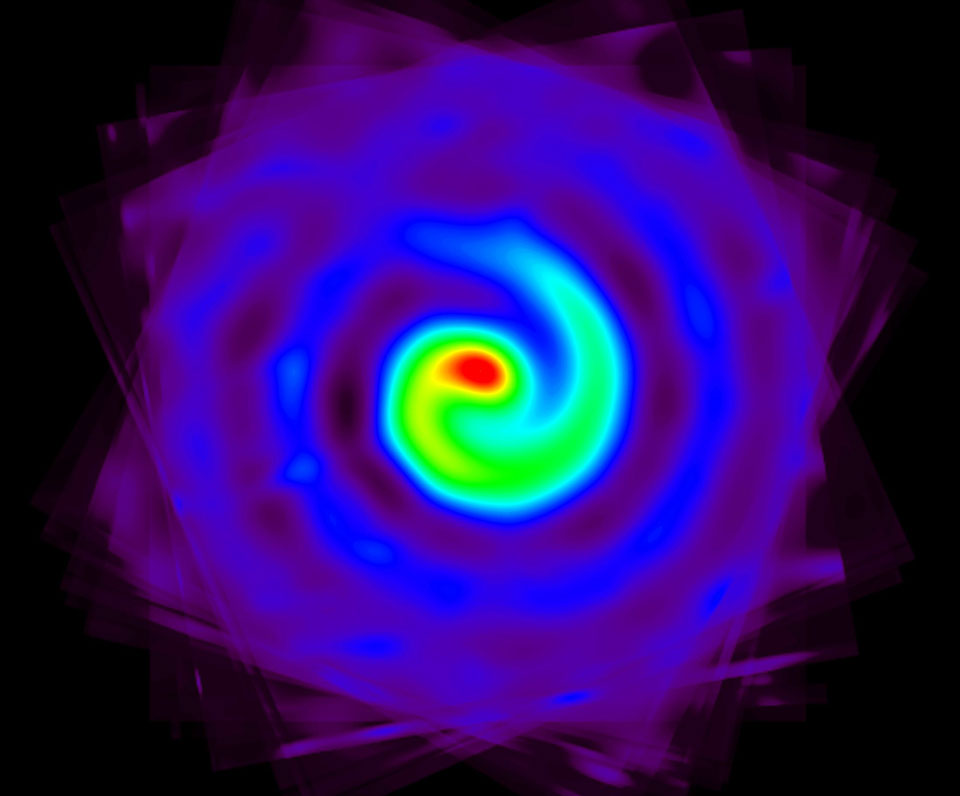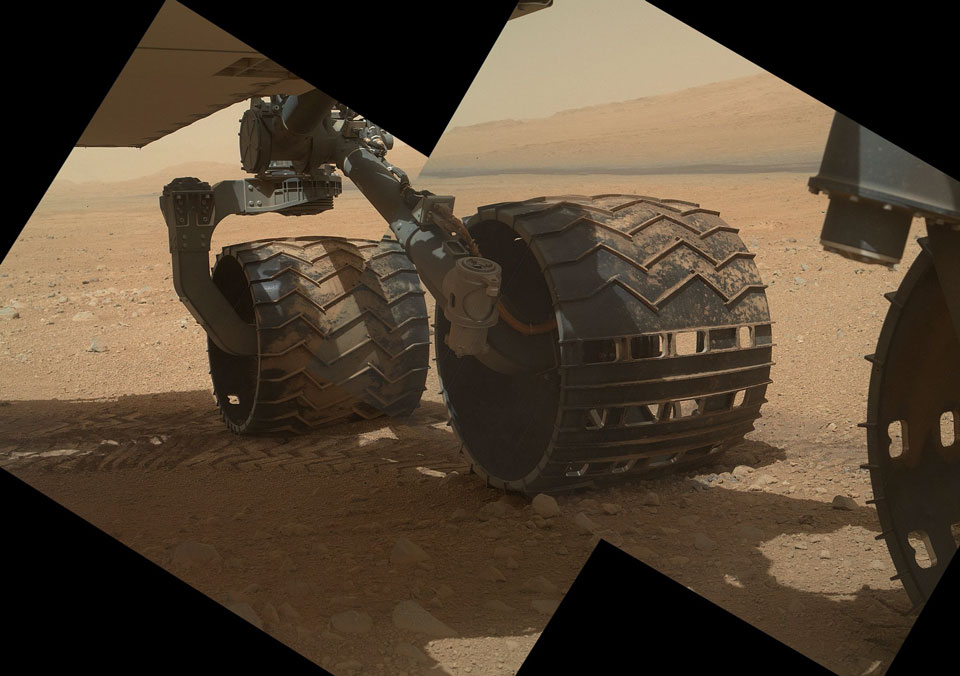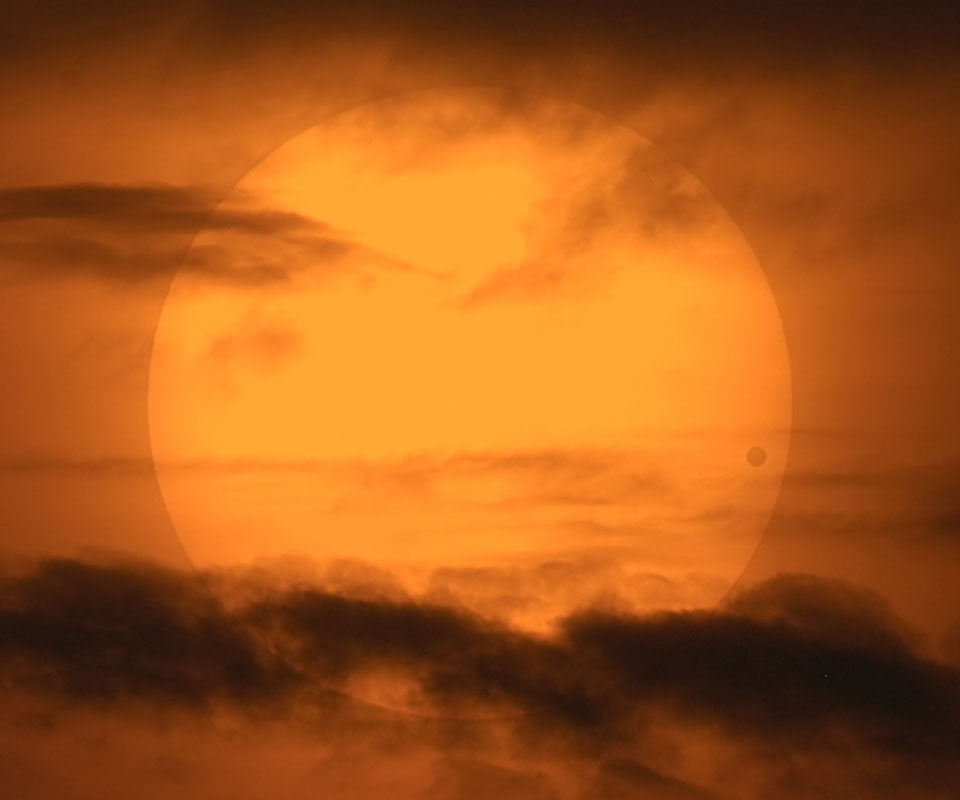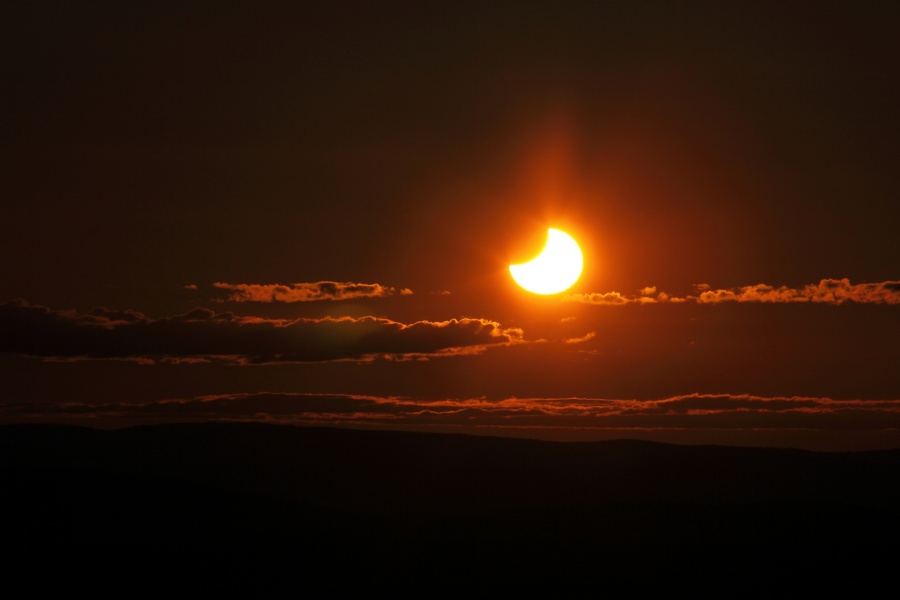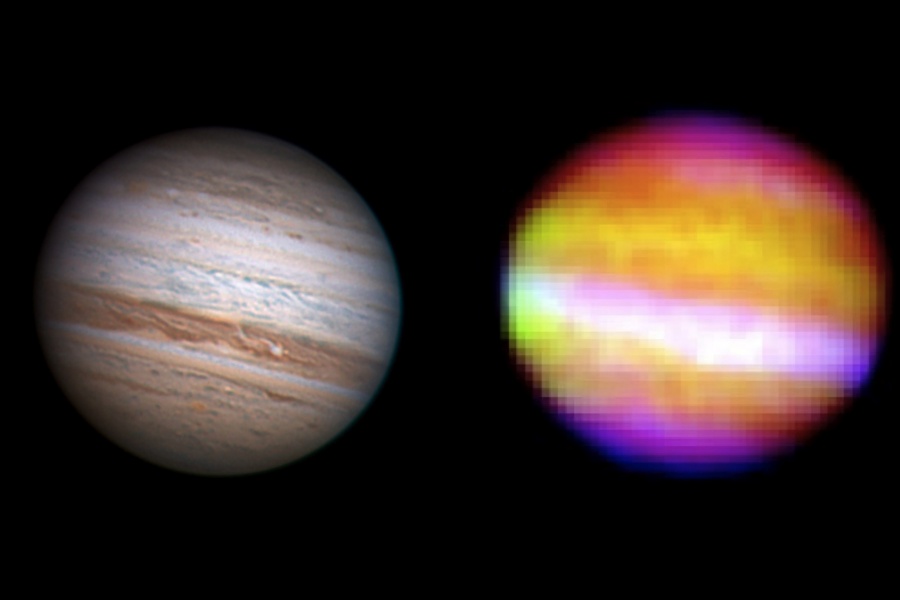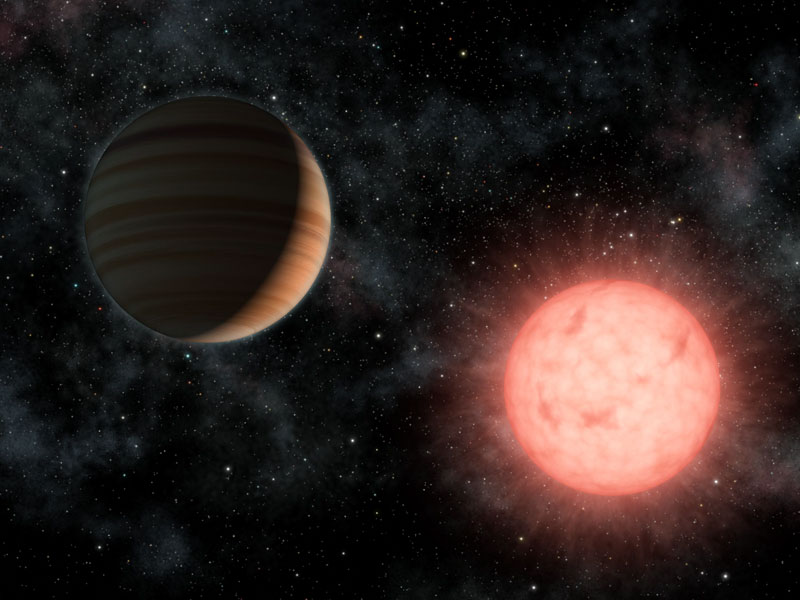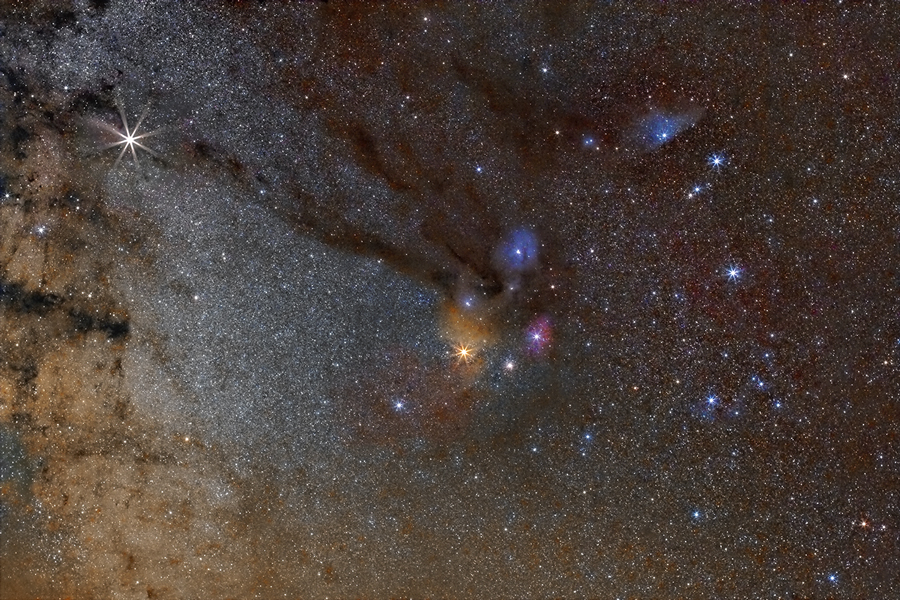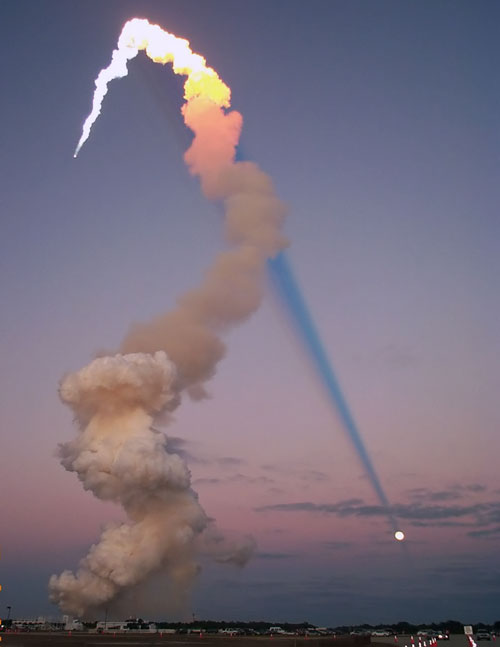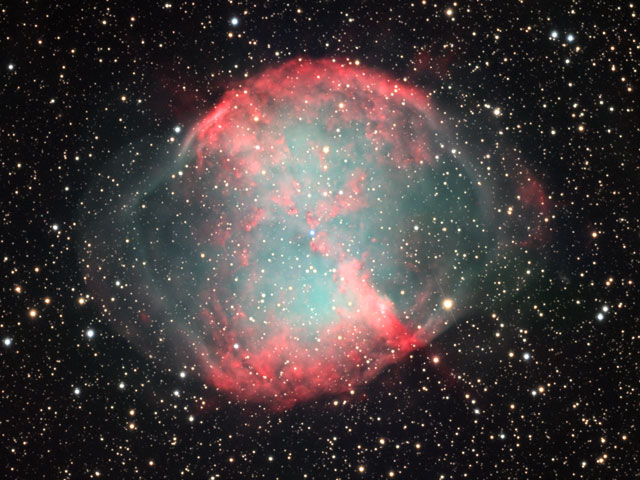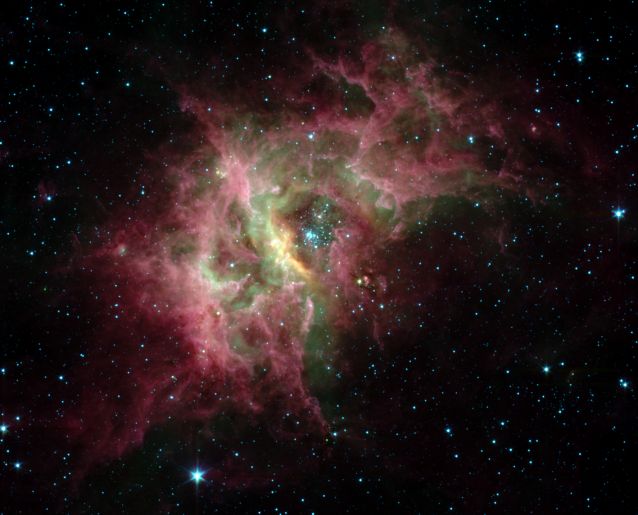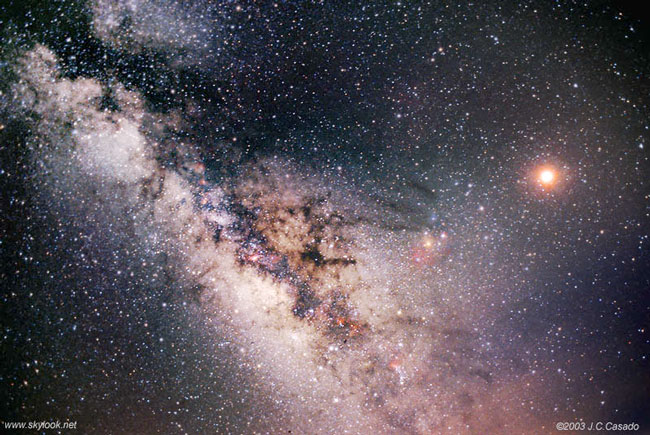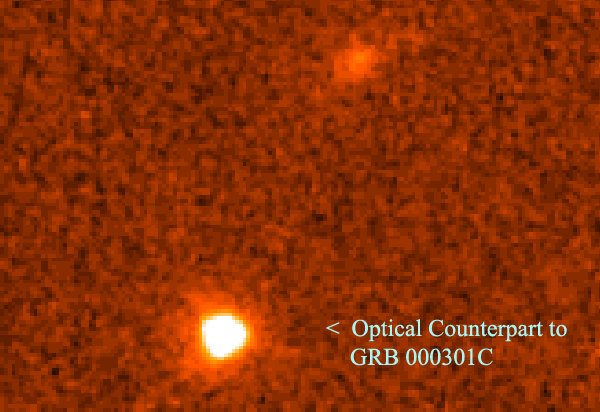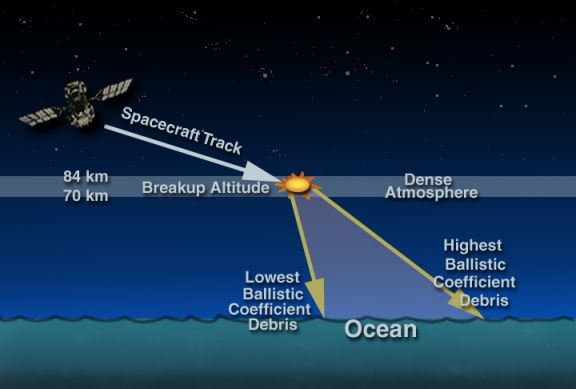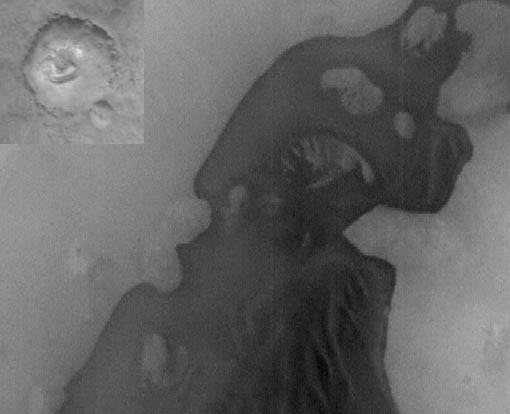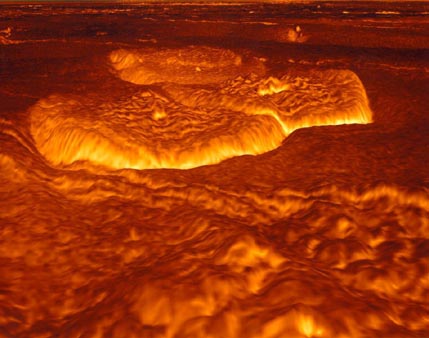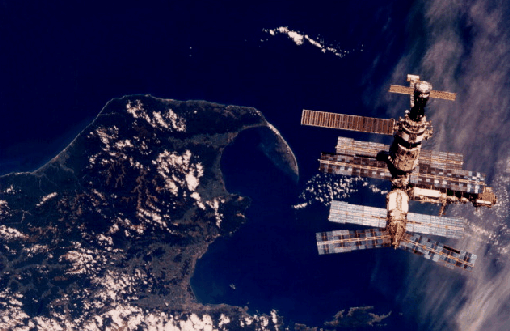| << Previous | Index | Next >> |
2015 Why does this moon look like a sponge? To better investigate, NASA and ESA sent the Saturn-orbiting robotic spacecraft Cassini zooming past Saturn's moon Hyperion, once again, earlier this week. One of the images beamed back to Earth is featured above, raw and unprocessed. Visible, as expected, are many unusually shaped craters with an unusual dark material at the bottom. Although Hyperion spans about 250 kilometers, its small gravitational tug on Cassini indicates that it is mostly empty space and so has very low surface gravity. Therefore, the odd shapes of many of Hyperion's craters are thought to result from impacts that primarily compress and eject surface material -- instead of the more typical round craters that appear after a circular shock wave that explosively redistributes surface material. Cassini is on track for another flyby of Saturn's Dione in about two weeks.
2014 Might this giant pinwheel one-day destroy us? Probably not, but investigation of the unusual star system Wolf-Rayet 104 has turned up an unexpected threat. The unusual pinwheel pattern has been found to be created by energetic winds of gas and dust that are expelled and intertwine as two massive stars orbit each other. One system component is a Wolf-Rayet star, a tumultuous orb in the last stage of evolution before it explodes in a supernova -- an event possible anytime in the next million years. Research into the spiral pattern of the emitted dust, however, indicates the we are looking nearly straight down the spin axis of the system -- possibly the same axis along which a powerful jet would emerge were the supernova accompanied by a gamma-ray burst. Now the WR 104 supernova itself will likely be an impressive but harmless spectacle. Conversely, were Earth really near the center of the powerful GRB beam, even the explosion's 8,000 light year distance might not be far enough to protect us. Currently, neither WR 104 nor GRB beams are understood well enough to know the real level of danger.
2013 Could life ever have existed on Mars? To help find out, humanity landed the Curiosity rover on Mars last August. To make sure the car-sized explorer survived the interplanetary trip and dramatic landing intact, the above image and others was taken peering at, under, and around Curiosity. Pictured above in this unusual vista are three of Curiosity's six wheels, each measuring about half a meter across. In recent months, Curiosity has been exploring the surroundings of an area dubbed Yellowknife Bay. Analyses of data taken by Curiosity's cameras and onboard laboratories has provided strong new evidence that Mars could once have supported life. In the distance is part of the slope to the central peak inside Gale Crater that Curiosity is scheduled to attempt to climb -- Mt. Sharp.
2012 The rare transit of Venus across the face of the Sun in 2004 was one of the better-photographed events in sky history. Both scientific and artistic images flooded in from the areas that could see the transit: Europe and much of Asia, Africa, and North America. Scientifically, solar photographers confirmed that the black drop effect is really better related to the viewing clarity of the camera or telescope than the atmosphere of Venus. Artistically, images might be divided into several categories. One type captures the transit in front of a highly detailed Sun. Another category captures a double coincidence such as both Venus and an airplane simultaneously silhouetted, or Venus and the International Space Station in low Earth orbit. A third image type involves a fortuitous arrangement of interesting looking clouds, as shown by example in the above image taken from North Carolina, USA. Sky enthusiasts worldwide are abuzz about the coming transit of Venus on Tuesday. It is perhaps interesting to wonder whether any person will live to see -- and remember seeing -- both Tuesday's Venus transit and the next one in 2117.
2011 On June 1, the shadow of the New Moon was cast across a land of the midnight Sun in this year's second partial solar eclipse. This picture of the geocentric celestial event above the Arctic Circle was taken near midnight from northern Finland's Kaunispää Hill in Lapland. Of course the region's reindeer were able to watch as both Moon and Sun hugged the northern horizon just above a cloud bank. Also visible from parts of Alaska and Canada, the eclipse began at sunrise in Siberia and northern China at 19:25 UT, ending about 3.5 hours later north of Newfoundland in the Atlantic Ocean. Remarkably, just one lunation later, on July 1 the New Moon's shadow will again reach out and touch the Earth in a partial solar eclipse, limited in visibility to a relatively small area in the Antarctic Ocean. July's eclipse will be followed by the fourth and final partial solar eclipse of 2011 on November 25. That eclipse will be seen from a southern land of the midnight Sun.
2010 SOFIA, the Stratospheric Observatory for Infrared Astronomy, captured its "first light" images on May 26, from an altitude of 35,000 feet. While flying above most of planet Earth's infrared-absorbing water vapor, SOFIA's premier infrared views of the cosmos included this remarkable false-color image (right panel) of Jupiter. For comparison, on the left is a recent, ground-based visible light image. Both show our solar system's ruling gas giant without its dark southern equatorial belt (normally seen in the upper hemisphere in this orientation). That familiar feature faded from view early in May. But the bright white stripe in SOFIA's image is a region of Jupiter's clouds transparent to infrared light, offering a glimpse below the cloud tops.
2009 Can a planet be as large as the star that it orbits? Recent observations have discovered that nearby Van Biesbroeck's star might have just such a large planet. Although VB 10 lies only about 20 light years away, it is a small red dwarf star so dim, at 17th magnitude, that a telescope is needed to see it. Van Biesbroeck's star was previously known for its rapid proper motion across the sky -- it moves so fast it could cross a full moon in only about 1,000 years. By noting a wiggle in VB 10's sky trajectory, astronomers were able to infer the existence of a planet several times the mass of Jupiter. Although the star VB 10 is perhaps 10 times more massive than the discovered planet VB 10b, the star is likely more highly compressed and so the two might be closely matched in size. Such a system is envisioned above with an artist's illustration. Since faint M-type stars like VB 10 are so common, planetary systems surrounding them, including planets larger than their parent star, might be more common than planetary systems like our own Solar System.
2008 Connecting the Pipe Nebula to the bright star Antares is a flowing dark cloud nicknamed the Dark River. The murkiness of the Dark River is caused by absorption of background starlight by dust, although the nebula contains mostly hydrogen and molecular gas. Antares, the bright star that appears yellow just below the center of the frame, is embedded in the colorful Rho Ophiuchi nebula clouds. The Dark River, pictured above across the upper left, spans over 20 times the angular diameter of the Moon and lies about 500 light years distant. Other types of nebulas visible here include red emission nebula and the blue reflection nebula.
2007 Why would the shadow of a space shuttle launch plume point toward the Moon? In early 2001 during a launch of Atlantis, the Sun, Earth, Moon, and rocket were all properly aligned for this photogenic coincidence. First, for the space shuttle's plume to cast a long shadow, the time of day must be either near sunrise or sunset. Next, just at sunset, the shadow is the longest and extends all the way to the horizon. Finally, during a Full Moon, the Sun and Moon are on opposite sides of the sky. Just after sunset, for example, the Sun is slightly below the horizon, and, in the other direction, the Moon is slightly above the horizon. Therefore, as Atlantis blasted off, just after sunset, its shadow projected away from the Sun toward the opposite horizon, where the Full Moon just happened to be.
2006 The pixelated planet above is actually our own planet Earth seen in gamma rays - the most energetic form of light. In fact, the gamma rays used to construct this view pack over 35 million electron volts (MeV) compared to a mere two electron volts (eV) for a typical visible light photon. The Earth's gamma-ray glow is indeed very faint, and this image was constructed by combining data from seven years of exposure during the life of the Compton Gamma Ray Observatory, operating in Earth orbit from 1991 to 2000. Brightest near the edge and faint near the center, the picture indicates that the gamma rays are coming from high in Earth's atmosphere. The gamma rays are produced as the atmosphere interacts with high energy cosmic rays from space, blocking the harmful radiation from reaching the surface. Astronomers need to understand Earth's gamma-ray glow well as it can interfere with observations of cosmic gamma-ray sources like pulsars, supernova remnants, and distant active galaxies powered by supermassive black holes.
2005 The first hint of what will become of our Sun was discovered inadvertently in 1764. At that time, Charles Messier was compiling a list of diffuse objects not to be confused with comets. The 27th object on Messier's list, now known as M27 or the Dumbbell Nebula, is a planetary nebula, the type of nebula our Sun will produce when nuclear fusion stops in its core. M27 is one of the brightest planetary nebulae on the sky, and can be seen in the constellation Vulpecula with binoculars. It takes light about 1000 years to reach us from M27, shown above, digitally sharpened, in three standard colors. Understanding the physics and significance of M27 was well beyond 18th century science. Even today, many things remain mysterious about bipolar planetary nebula like M27, including the physical mechanism that expels a low-mass star's gaseous outer-envelope, leaving an X-ray hot white dwarf.
2004 Stars and planets appear to be under construction in dusty nebula RCW 49. This Spitzer Space Telescope false-color infrared view of the nearby stellar nursery shows that known, hot stars are well on their way to clearing out the nebula's central regions. But it also uncovers more than 300 newborn stars, seen here strewn throughout the cosmic dust clouds and filaments. The infrared data indicate the likely presence of protoplanetary discs around some of the infant suns, among the faintest and farthest potential planet-forming discs ever observed. Such exciting results give further support to the idea that planet-forming discs are a natural part of a star's evolution. A mere 14,000 light-years away toward the constellation Centaurus, the industrious RCW 49 is about 350 light-years across.
2003 What's behind the Moon? Each month, our Moon passes in front of -- and outshines -- many an interesting star field. Exceptions occur during a new Moon and during a total eclipse. In the background of a new Moon is usually the Sun, an even brighter orb that even more easily outshines everything behind it, except during a total solar eclipse. Even the longest total solar eclipse lasts just a few minutes, while the Sun's corona still remains bright. During a total lunar eclipse, however, the full Moon dims and a majestic star field may present itself for an hour or more. Such was the case during the middle of last month, when a rare glimpse of an eclipsed Moon superposed in front of the disk of our home Milky Way Galaxy was captured. Although fully in the Earth's shadow, the eclipsed Moon is still the brightest object on the right. The above image was captured during sub-zero weather from the Teide 2003 expedition to Mirador del Pico Viejo, a mountain in the Canary Islands, Spain, off the northwest coast of Africa.
2002 Why are huge clouds of gas billowing from spiral galaxy NGC 4388? The extent of the gas clouds, over 100,000 light-years, was unexpected before the Subaru Telescope took the above image. NGC 4388 has a bright energetic nucleus and so is classified as an active galaxy. The spiral, relatively close by at 60 million light years, is a member of the nearest major cluster of galaxies: the Virgo Cluster. One hypothesis holds that the gas was stripped away as NGC 4388 made its way through the intergalactic medium of the Virgo Cluster. A competing hypothesis holds that the gas is all that remains of a smaller galaxy that was gravitationally deconstructed by the larger NGC 4388. Further observations may better determine NGC 4388's past and likely contribute to a better understanding of how galaxies evolve inside massive clusters.
2001 Last March, telescopic instruments in Earth and space tracked a tremendous explosion that occurred across the universe. A nearly unprecedented symphony of international observations began abruptly on 2000 March 1 when Earth-orbiting RXTE, Sun-orbiting Ulysses, and asteroid-orbiting NEAR all detected a 10-second burst of high-frequency gamma radiation. Within 48 hours astronomers using the 2.5-meter Nordic Optical Telescope chimed in with the observation of a middle-frequency optical counterpart that was soon confirmed with the 3.5-meter Calar Alto Telescope in Spain. By the next day the explosion was picked up in low-frequency radio waves by the by the European IRAM 30-meter dish in Spain, and then by the VLA telescopes in the US. The Japanese 8-meter Subaru Telescope interrupted a maiden engineering test to trumpet in infrared observations. Major telescopes across the globe soon began playing along as GRB 000301C came into view, detailing unusual behavior. The Hubble Space Telescope captured the above image and was the first to obtain an accurate distance to the explosion, placing it near redshift 2, most of the way across the visible universe. The Keck II Telescope in Hawaii quickly confirmed and refined the redshift. Even today, no one is sure what type of explosion this was. Unusual features of the light curve are still being studied, and no host galaxy appears near the position of this explosion.
2000 Nine years ago the massive Compton Gamma Ray Observatory, the second of NASA's space-based great observatories, was deployed in low earth orbit. Lofted above the protective atmosphere, Compton's instruments could explore the extreme high-energy Universe in gamma rays -- photons with 100,000 times or more the energy of visible light. The premier gamma-ray observatory far exceeded expectations for a two- to five-year mission, but a recent gyroscope failure has prompted NASA to decide to steer the satellite safely back into the atmosphere. Illustrated above, the controlled re-entry will occur early tomorrow, June 4th, in a remote area of the Pacific Ocean, approximately 2,500 miles southeast of Hawaii. The re-entry location, the largest area (about 10 million square miles) devoid of any populated land available for the observatory's re-entry, was selected to virtually eliminate the risk of human casualty. Compton's lasting legacy of discovery will include the detection of more than 400 celestial gamma-ray sources, 10 times more than were previously known; and more than 2,500 gamma-ray bursts.
1999 While hunting through Sloan Sky Survey data in search of distant quasars, Princeton astronomers Xiaohui Fan and Michael Strauss came upon an undiscovered type of object very nearby - now dubbed a methane dwarf. Marked by white lines in this recently released image, the isolated, faint, but extremely red methane dwarf lies only 30 or so light-years away in the constellation Ophiuchus. Intermediate in size between a star and a planet, it is thought to be about 10 to 70 times as massive as Jupiter. The moniker "methane dwarf" was derived from the strong signature of methane gas in the object's spectrum. Along with the red color, the presence of methane (CH4) indicates that this object is cool - cooler than brown dwarfs which lack the strong methane signature yet are the only other known objects in this mass range. Subsequent observations have now raised the total to three detected methane dwarfs, but because they are so difficult to find so far no one knows if they are rare or common in our Galaxy.
1998 Did a pond once exist in this Martian crater? Recent photographs by the spacecraft Mars Global Surveyor, currently in orbit around Mars, show features unusual for Mars yet similar to a dried pond on Earth. Previously, much evidence suggested the effects of ancient channels of flowing water on Mars, but less evidence had been found for dried pools of water. Islands and bays on this crater floor indicate an accumulation of some liquid, however, a hypothesis consistent with channels found on the (inset) crater walls. As it is also possible the features were formed by other mechanisms including flowing lava, future observations and analysis will be needed to say for sure.
1997 If you could look at Venus with radar eyes - this is what you might see. This computer reconstruction of the surface of Venus was created from data from the Magellan spacecraft. Magellan orbited Venus and used radar to map our neighboring planet's surface between 1990 and 1994. Magellan found many interesting surface features, including the large circular domes, typically 25-kilometers across, that are depicted above. Volcanism is thought to have created the domes, although the precise mechanism remains unknown. Venus' surface is so hot and hostile that no surface probe has lasted more than a few minutes.
1996 This dream-like image of Mir was recorded by astronauts as the Space Shuttle Atlantis approached the Russian Space Station prior to docking during the STS-76 mission. Sporting spindly appendages and solar pannels, Mir resembles a whimsical flying insect as it orbits above New Zealand's South Island near the Cook Strait. Atlantis shuttled astronaut Shannon W. Lucid to Mir for a 140 day visit, increasing the Mir's occupancy from 2 to 3. It will return to pick Lucid up and drop off astronaut John Blaha during the STS-79 mission presently scheduled for launch on July 31, 1996.
| << Previous | Index | Next >> |
